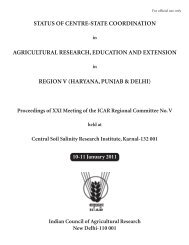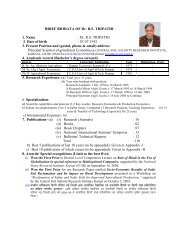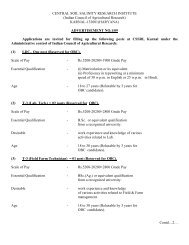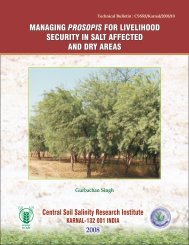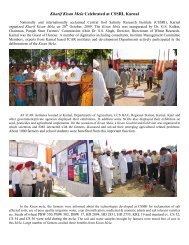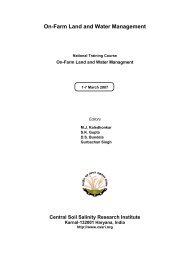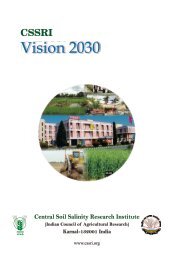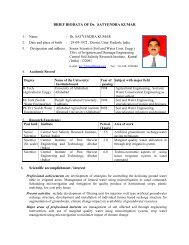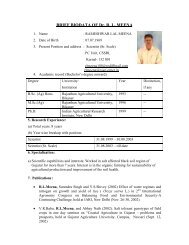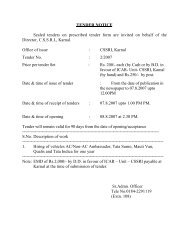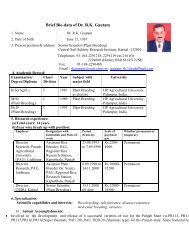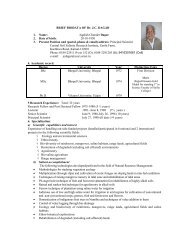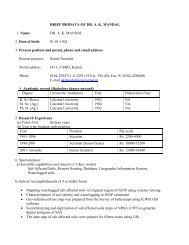BIOSAFOR - BIOSALINE (AGRO) FORESTRY - Central Soil Salinity ...
BIOSAFOR - BIOSALINE (AGRO) FORESTRY - Central Soil Salinity ...
BIOSAFOR - BIOSALINE (AGRO) FORESTRY - Central Soil Salinity ...
You also want an ePaper? Increase the reach of your titles
YUMPU automatically turns print PDFs into web optimized ePapers that Google loves.
v Among the exotic species Acacia salicina, Acacia ampliceps and Casuarina glauca showed good salinity<br />
tolerance and biomass production potential<br />
Research Achievements of Wp 1 for Overall Project<br />
§ More than 70 tree species/accessions (s/a) were tested for all countries with different soil, water and<br />
climatic conditions.<br />
§ Forty five (s/a) successfully survived under different salinity conditions.<br />
§ In most cases, a given s/a have been tested at least in two different countries, whereas, local s/a have been<br />
tested in one site (country as well).<br />
§ Among local species/accessions, Prosopis alba, P. juilfora and P. glandulosa showed higher biomass. They<br />
also showed higher C50 and C0 (22-36 dS/m) values, indicating that local species/accessions have high<br />
potential for bioforestry projects.<br />
§ Species that showed higher biomass and salinity tolerance include Acacia ampliceps accessions, with C 0<br />
values varying from 21-41 dS/m. However, their threshold salinity ranges are very low (2.63-6.41 dS/m)<br />
WORK PACKAGE 2<br />
Objective of this work package was to acquire specific information on saline sites where the trees do prevail<br />
naturally and the performance of these trees in various – saline environments thereby enabling conclusions<br />
on best practices.<br />
Methods<br />
Selection of sites in partner countries was first based on broader criteria:<br />
— The site should be classified as saline and/or sodic and/or waterlogged in its typical definition<br />
— Plantations should be at least in a 5 ha area and of 5 years or older<br />
— Accessibility of the plantation to the project staff<br />
Within each sites, selection of individual trees were based on either (i) salinity/sodicity categories within the<br />
plantation area; and (ii) growth categories of individual trees – if there was no heterogeneity on soil salinity<br />
data.<br />
Studies at the case study sites having plantations on saline and sodic lands - eight in India, five in Pakistan<br />
and two in Bangladesh were conducted and /or monitored providing very useful data to establish<br />
relationship between growth and biomass of the test species based on real long-term data on plantations on<br />
saline and sodic lands.<br />
Results<br />
Studies at the case study sites having plantations on saline and sodic lands - eight in India , five in Pakistan<br />
and two in Bangladesh were conducted and /or monitored providing very useful data to establish<br />
relationship between growth and biomass of the test species based on real long-term data on plantations on<br />
saline and sodic lands. CSSRI, Karnal conducted studies at five sites, namely Saraswati, Shivri (Lucknow)<br />
and Karnal on sodic soils and Hisar and Sampla for saline soils to measure and estimate the potential of<br />
mature salt tolerant trees in various saline environments.<br />
Biomass Production in Sodic <strong>Soil</strong>s<br />
Biomass of trees at CSSRI, Karnal<br />
Based on historic data available at CSSRI, Karnal, when trees were raised on alkali soil during 1980s, biomass<br />
of ten years old Prosopis juliflora, Acacia nilotica, Casuarina equesitifolia and Eucalyptus tereticornis was<br />
harvested and found to be 156, 129, 113 and 89 kg per tree total biomass (biomass obtained in annual loppings<br />
in the previous years is not included) (Fig. 5).<br />
15



